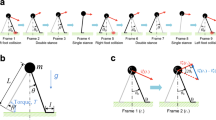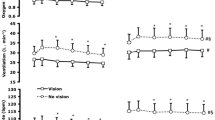Abstract
Treadmill locomotion is different with respect to overground walking and may require an adapted control mode. The relevant neural computational effort may produce lasting effects encroaching upon the performance of a subsequent postural task. The hypothesis of the present study was that, contrary to overground walking, treadmill walking has effects on quiet stance variables, in the assumption that the imposed locomotor activity is more critical to stance control than natural walking. Nine young subjects performed three different walking sessions: treadmill with eyes closed, treadmill with eyes open, overground walking with eyes open. Body sway area and sway path and the position of the centre of foot pressure during stance were recorded by a dynamometric platform under control, post-walking and post-recovery conditions, alternatively with eyes closed and eyes open. At variance with overground walking, treadmill locomotion produced an effect on body orientation in space during the subsequent stance trials. This consisted in a forward inclination of the body, not accompanied by increased body sway, lasting for a few minutes. Presence or absence of vision during treadmill locomotion did not induce differences in the amplitude or time-course of the post-effect. We argue that body inclination would be the consequence of a change in the postural reference produced by a message arising from treadmill locomotion itself, possibly connected to particularities in the control mode of this type of walking.




Similar content being viewed by others
References
Alton F, Baldey L, Caplan S, Morrissey MC (1998) A kinematic comparison of overground and treadmill walking. Clin Biomech (Bristol, Avon) 13:434–440
Courtine G, De Nunzio AM, Schmid M, Beretta MV, Schieppati M (2007) Stance- and locomotion-dependent processing of vibration-induced proprioceptive inflow from multiple muscles in humans. J Neurophysiol 97:772–779
De Nunzio AM, Nardone A, Schieppati M (2005) Head stabilization on a continuously oscillating platform: the effect of a proprioceptive disturbance on the balancing strategy. Exp Brain Res 165:261–272
Derave W, Tombeux N, Cottyn J, Pannier JL, De Clercq D (2002) Treadmill exercise negatively affects visual contribution to static postural stability. Int J Sports Med 23:44–49
Dickstein R, Laufer Y (2004) Light touch and center of mass stability during treadmill locomotion. Gait Posture 20:41–47
Diener HC, Dichgans J, Bacher M, Gompf B (1984) Quantification of postural sway in normals and patients with cerebellar diseases. Electroencephalogr Clin Neurophysiol 57:134–142
Dingwell JB, Cusumano JP, Cavanagh PR, Sternad D (2001) Local dynamic stability versus kinematic variability of continuous overground and treadmill walking. J Biomech Eng 123:27–32
Duclos C, Roll R, Kavounoudias A, Roll JP (2004) Long-lasting body leanings following neck muscle isometric contractions. Exp Brain Res 158:58–66
Frenkel-Toledo S, Giladi N, Peretz C, Herman T, Gruendlinger L, Hausdorff JM (2005) Treadmill walking as an external pacemaker to improve gait rhythm and stability in Parkinson’s disease. Mov Disord 20:1109–1114
Gramsbergen A (2005) Postural control in man: the phylogenetic perspective. Neural Plast 12:77–88
Hashiba M (1998) Transient change in standing posture after linear treadmill locomotion. Jpn J Physiol 48:499–504
Hesse S (2001) Locomotor therapy in neurorehabilitation. NeuroRehabilitation 16:133–139
Ivanenko YP, Wright WG, Gurfinkel VS, Horak F, Cordo P (2006) Interaction of involuntary post-contraction activity with locomotor movements. Exp Brain Res 169:255–260
Kavounoudias A, Roll R, Roll JP (1998) The plantar sole is a ‘dynamometric map’ for human balance control. Neuroreport 9:3247–3252
Kluzik J, Horak FB, Peterka RJ (2005) Differences in preferred reference frames for postural orientation shown by after-effects of stance on an inclined surface. Exp Brain Res 162:474–489
Kluzik J, Horak FB, Peterka RJ (2007) Postural after-effects of stepping on an inclined surface. Neurosci Lett 413:93–98
Lackner JR, Graybiel A (1980) Visual and postural motion aftereffects following parabolic flight. Aviat Space Environ Med 51:230–233
Lepers R, Bigard AX, Diard JP, Gouteyron JF, Guezennec CY (1997) Posture control after prolonged exercise. Eur J Appl Physiol Occup Physiol 76:55–61
Lepers R, Breniere Y, Maton B (1999) Changes to the gait initiation programme following a running exercise in human subjects. Neurosci Lett 260:69–73
Maurer C, Mergner T, Peterka RJ (2005) Multisensory control of human upright stance. Exp Brain Res 24:1–20
Maurer C, Schweigart G, Mergner T (2006) Pronounced overestimation of support surface tilt during stance. Exp Brain Res 168:41–50
Mulavara AP, Verstraete MC, Bloomberg JJ (2002) Modulation of head movement control in humans during treadmill walking. Gait Posture 16:271–282
Murray MP, Spurr GB, Sepic SB, Gardner GM, Mollinger LA (1985) Treadmill vs. floor walking: kinematics, electromyogram, and heart rate. J Appl Physiol 59:87–91
Nagano A, Yoshioka S, Hay DC, Himeno R, Fukashiro S (2006) Influence of vision and static stretch of the calf muscles on postural sway during quiet standing. Hum Mov Sci 25:422–434
Nardone A, Tarantola J, Giordano A, Schieppati M (1997) Fatigue effects on body balance. Electroencephalogr Clin Neurophysiol 105:309–320
Peterka RJ, Loughlin PJ (2004) Dynamic regulation of sensorimotor integration in human postural control. J Neurophysiol 91:410–423
Prokop T, Schubert M, Berger W (1997) Visual influence on human locomotion. Modulation to changes in optic flow. Exp Brain Res 114:63–70
Schieppati M, Hugon M, Grasso M, Nardone A, Galante M (1994) The limits of equilibrium in young and elderly normal subjects and in Parkinsonians. Electroencephalogr Clin Neurophysiol 93:286–298
Schmid M, De Nunzio AM, Schieppati M (2005) Trunk muscle proprioceptive input assists steering of locomotion. Neurosci Lett 384:127–132
Stolze H, Kuhtz-Buschbeck JP, Mondwurf C, Boczek-Funcke A, Johnk K, Deuschl G, Illert M (1997) Gait analysis during treadmill and overground locomotion in children and adults. Electroencephalogr Clin Neurophysiol 105:490–497
Tarantola J, Nardone A, Tacchini E, Schieppati M (1997) Human stance stability improves with the repetition of the task: effect of foot position and visual condition. Neurosci Lett 228:75–78
Thorstensson A, Nilsson J, Carlson H, Zomlefer MR (1984) Trunk movements in human locomotion. Acta Physiol Scand 121:9–22
van de Crommert HW, Mulder T, Duysens J (1998) Neural control of locomotion: sensory control of the central pattern generator and its relation to treadmill training. Gait Posture 7:251–263
Vogt L, Banzer W (1999) Vergleichende oberflächenelektromyographische Untersuchung ausgewählter Rumpf- und Hüftmuskeln beim Gehen auf der freien Gehstrecke und dem Laufbandergometer. Dtsch Z Sportmed 50:84–88
Vogt L, Pfeifer K, Banzer W (2002) Comparison of angular lumbar spine and pelvis kinematics during treadmill and overground locomotion. Clin Biomech (Bristol, Avon) 17:162–165
Warabi T, Kato M, Kiriyama K, Yoshida T, Kobayashi N (2005) Treadmill walking and overground walking of human subjects compared by recording sole-floor reaction force. Neurosci Res 53:343–348
Weber KD, Fletcher WA, Gordon CR, Melvill Jones G, Block EW (1998) Motor learning in the ‘podokinetic’ system and its role in spatial orientation during locomotion. Exp Brain Res 120:377–385
Wierzbicka MM, Gilhodes JC, Roll JP (1998) Vibration-induced postural posteffects. J Neurophysiol 79:143–150
Wolpaw JR, Tennissen AM (2001) Activity-dependent spinal cord plasticity in health and disease. Annu Rev Neurosci 24:807–843
Wright WG, Glasauer S (2003) Haptic subjective vertical shows context dependence: task and vision play a role during dynamic tilt stimulation. Ann N Y Acad Sci 1004:531–555
Acknowledgments
This work was supported by the FIRB 2001 (RBNE01FJ4J) and PRIN 2005 (2005059738) grants from the Italian Ministry of University and Research (MIUR).
Author information
Authors and Affiliations
Corresponding author
Rights and permissions
About this article
Cite this article
Zanetti, C., Schieppati, M. Quiet stance control is affected by prior treadmill but not overground locomotion. Eur J Appl Physiol 100, 331–339 (2007). https://doi.org/10.1007/s00421-007-0434-7
Accepted:
Published:
Issue Date:
DOI: https://doi.org/10.1007/s00421-007-0434-7




